
Kansas Geological Survey, Open-file Report 1999-23
by
David P. Young, Jill M. Whitmer, and Donald O. Whittemore
KGS Open-file Report 1999-23
June 1999
Appreciation is expressed to local, federal, and other state agencies and institutions for assistance in conducting the Upper Arkansas River Corridor (UARC) study. The study is being conducted in cooperation with the Kansas Water Office; Division of Water Resources, Kansas Department of Agriculture; Pesticide Program, Kansas Department of Agriculture; Southwest Kansas Groundwater Management District No. 3; Kansas Department of Health and Environment; and Southwest Kansas Local Environmental Planning Group. The UARC study is partially funded by the State Water Plan through the Kansas Water Office.
Other members of the Geohydrology section provided useful input. Melany Miller assisted in the production of the report. Mark Schoneweis and Lee Bissinger provided assistance with graphics. Thanks to Susan Stover for her thorough review and comments that helped to improve the report.
This report presents lithologic characterization of the unconsolidated Tertiary and Quaternary deposits that compose the aquifer system underlying Gray and Ford counties, particularly along the Arkansas River corridor west of the Crooked Creek-Fowler fault. It includes a brief review of literature concerning the geology and hydrology of the study area, and describes geologic cross sections developed for Gray and Ford counties.
A procedure was developed to electronically represent, manage, and display lithologic data as cross sections with accompanying color gradation. The cross sections help to characterize the shallow alluvial aquifer, the deeper High Plains aquifer, and a relatively impermeable layer that commonly is present between the two aquifers. The alluvial aquifer comprises a fairly continuous permeable unit of sands and gravels, especially south of the Arkansas River. The thickness of the permeable material varies considerably and exceeds 50 feet in places. The alluvial valley north of the Arkansas River is quite narrow in stretches and the alluvial aquifer typically is thinner and less continuous. The deeper High Plains aquifer varies widely in type of material, thickness, and layer continuity. This aquifer has more clay, silt, and cemented units than the alluvial aquifer. The relatively impermeable layer between the aquifers is discontinuous and highly variable in thickness and materials composition. It is generally made up of clay interbedded with lenses of silt, caliche or (cemented) sand. Geologic sections suggest that greater hydraulic connection between the shallow and deep aquifers occurs south of the Arkansas River.
The Arkansas River in southeastern Colorado and westernmost Kansas is one of the most saline rivers in the United States. Consumption of water by evapotranspiration in Colorado has substantially decreased the flow and greatly increased the salinity of the river water entering Kansas. In addition to salinity, the concentration of many other dissolved constituents in the river water is high.
Ground-water levels have declined in the High Plains aquifer in southwest Kansas from decreased recharge from the river and consumptive pumping from the aquifer. As a result, some or all of the Arkansas River flow entering Kansas from Colorado is lost in the river stretch from the state line to Dodge City. Some of this loss is due to infiltration and consumptive use of water diverted from the river for irrigation and also to phreatophyte transpiration and river evaporation. Saline water from the river and fields irrigated with river water is infiltrating to and contaminating the ground water in the alluvial and High Plains aquifers in the upper Arkansas River corridor. Ground-water declines in the High Plains aquifer have also decreased the amount of fresh subsurface flow to the alluvium that can dilute salinity and other constituent concentrations. Another ground-water quality problem in the upper Arkansas River corridor is increasing nitrate concentrations in many well waters. The ground waters which have been and could become contaminated by salinity and nitrate include sole sources for several towns and cities, including Syracuse, Lakin, Garden City, Cimarron, and Dodge City.
The distribution of salinity and the mechanisms for entrance to and movement of the saline water within the aquifer system have not been well known. An assessment of the source, migration, and present and possible future extent of the ground water contamination is critical for developing plans for minimizing or mitigating water-quality problems in the aquifers. The Upper Arkansas River Corridor Study was developed to provide information that will improve understanding of the river and ground-water salinity in the corridor to enable agencies, municipalities, farmers, and industries in the area to better manage water resources to minimize or mitigate water-quality problems.
Layers of low permeability clays and silty clays typically underlie the Arkansas River alluvium. This low-permeability material restricts the infiltration of the saline river water to the deeper ground water. As a result, perched saline water exists in some areas above the main body of the High Plains aquifer. Clay layers also occur within the main aquifer and further retard the downward movement of saline water. The sand and gravel units comprising the alluvial and High Plains aquifers vary substantially in hydraulic conductivity and thickness. The distribution and character of the low and high permeability layers in the aquifer system (both the alluvial and High Plains aquifers in most of the study area) have not been well known. Understanding of the distribution of the different lithologic units is necessary for conceptual and quantitative models of the intrusion of the saline river water in the areas of the river valley and ditch irrigation, and the migration of the saline water within the High Plains aquifer.
Description of components of the objectives and scope of work for the overall project have been listed by Whittemore et al. (1996). This report addresses objectives related to the intrusion of the saline water into the alluvial and High Plains aquifers and migration of the intruded water. It describes the lithology of unconsolidated sediment deposits in Gray and Ford counties. It includes a brief review of previous literature on geology and hydrology, and presents and discusses geologic cross sections produced for the Arkansas River corridor and surrounding area in Gray and Ford counties. A similar report by Young et al. (1998) describes the lithology of the unconsolidated deposits underlying Kearny and Finney counties.
Many studies have dealt with the geology and water resources of southwestern Kansas. The literature covering the entire Upper Arkansas River Corridor study area was reviewed by Young et al. (1997). Historical data were obtained from the following reports: Lobmeyer and Sauer (1974) [Hamilton County]; McLaughlin (1943) [Hamilton and Kearny counties]; Gutentag et al. (1972a) [Kearny County]; Dunlap et al. (1985) [Kearny and Finney counties]; Meyer et al. (1969, 1970) and Gutentag et al. (1972b) [Finney County]; Latta (1944) [Finney and Gray counties]; McGovern and Long (1974) [Gray County]; Waite (1942) and Spinazola and Dealy [Ford County]; Gutentag et al. (1981) [southwest Kansas]; and O'Connor and McClain (1982), Stullken et al. (1985), and Watts and Stullken (1985) [western Kansas]. Most of these publications include generalized geologic cross sections, and some contain maps showing surficial and bedrock geology. The cross sections generally do not contain information on the lithology of the unconsolidated Tertiary and Quaternary deposits. Most of the information in the following sections reviewing the geology and hydrology was obtained from these publications.
The project study area covers approximately 3,560 sq. mi along the Arkansas River corridor from the Colorado state line to the Ford-Edwards county line in southwestern Kansas. It includes parts of Hamilton, Kearny, Finney, Gray, and Ford counties (Figure 1). Southwestern Kansas lies in the High Plains region of the Great Plains physiographic province.
Figure 1. Location of the area of the Upper Arkansas River Corridor Study within the 5-county region. The study area boundary is the bold line.

The surface geology of Gray and Ford counties is shown in Figure 2. Loess deposits mantle much of the upland areas. Dune sand covers a broad area south of the Arkansas River in Gray County, and occurs in a belt of varying width south of the river in Ford County, and in other isolated patches. Alluvium floors the Arkansas River valley and other stream valleys. Greenhorn Limestone and Graneros Shale are exposed in the northern part of Ford County where streams have cut through the younger deposits, and Greenhorn Limestone is also exposed in one isolated area in southeastern Gray County. The Dakota Formation is the oldest formation exposed.
Figure 2. Surface geology of Gray and Ford counties.

Tertiary and Quaternary deposits underlie most of Gray and Ford counties and range in thickness up to 550 feet, the thickest being in extreme southwestern Gray County. The saturated part of the Ogallala Formation of Pliocene age, the undifferentiated Pleistocene deposits, and the Quaternary alluvium in the Arkansas River corridor form the aquifer system in the study area. The Pliocene and undifferentiated Pleistocene deposits are hydraulically connected and lithologically similar, and are considered as one aquifer, the High Plains aquifer. In this report, the High Plains aquifer is differentiated from the shallower Arkansas River valley alluvial aquifer. Although both aquifers are hydraulically connected to some extent, the distinction is made on the basis of differences in water levels due to a relatively impermeable zone between them. Also, the permeability is greater in the Arkansas River alluvium. The Arkansas River meanders through the study area and interacts hydraulically with the aquifer system. The surface of the Cretaceous bedrock defines the lower limit of the aquifer system. In parts of the area, the Dakota aquifer may be considered as part of the aquifer system, but it will not be discussed in this report.
Consolidated rocks of Cretaceous age, which underlie the unconsolidated Tertiary and Quaternary deposits, are referred to as bedrock in this report. As a rule, Upper Cretaceous rocks form the bedrock surface in the northern part of the study area, and Upper and undifferentiated Lower Cretaceous rocks form the bedrock surface in the southern part of the study area. The relatively impermeable Upper Cretaceous rocks include Graneros Shale, Greenhorn Limestone, Carlile Shale, and Niobrara Chalk in Gray County. The Carlile Shale and Niobrara Chalk have been removed entirely by erosion in Ford County. Upper Cretaceous rocks crop out in areas where streams have eroded the Tertiary and Quaternary deposits, particularly in northern Ford County (Figure 2). The Dakota Formation (Lower Cretaceous) crops out in isolated areas, including just north of the Arkansas River in the vicinity of Ford.
The configuration of the bedrock surface underlying Gray and Ford counties, shown in Figure 3, indicates an eastward-trending drainage system that has been altered by faulting and subsidence associated with dissolution of Permian evaporites. The bedrock surface thus had a topography of considerable diversity and relief prior to the deposition of the Ogallala Formation.
Figure 3. Configuration of base of High Plains aquifer in Gray and Ford counties (after USGS, 1985).

During late Tertiary or early Quaternary time, subsidence occurred in southwestern Kansas as a result of dissolution of salt beds in underlying Permian rocks. The area of subsidence is bounded on the west by the Bear Creek fault, which crosses below the Arkansas River in Kearny County, and on the east by the Crooked Creek-Fowler fault, which crosses under the Arkansas River in Ford County. Vertical displacement across the fault may be as much as 250 ft. An area of buried sinkholes in central Ford County is associated with the Crooked Creek-Fowler fault and the zone of dissolution. Between the Bear Creek and Crooked Creek-Fowler faults, the irregular bedrock surface slopes at about 13.5 feet per mile. The gradient increases near the Crooked Creek-Fowler fault.
The sandstones of the Dakota aquifer (Lower Cretaceous) are used as a source of water in some locations. Upper Cretaceous rocks yield little or no water to wells. Table 1 provides a generalized description of the geologic formations in southwestern Kansas and their water-bearing properties.
Table 1. Generalized section of geologic formations and their water-bearing properties (from Gutentag et al., 1981). The classification and nomenclature of the stratigraphic units used in this report are those of the Kansas Geological Survey and differ somewhat from those of the U.S. Geological Survey.
| System | Series | Stratigraphic unit |
Thickness, Feet |
Physical character | Water supply |
|---|---|---|---|---|---|
| Quaternary | Pleistocene | Alluvium | 0-80 | Stream-laid deposits ranging from silt and clay to sand and gravel that occur along principal stream valleys. | Yields to wells range from 500 to more than 1,000 gal/min in the Arkansas River valley; 50 to 500 gal/min in the Pawnee River valley; and 50 to 1,000 gal/min in the Cimarron River valley. |
| Dune sand | 0-75 | Fine to medium quartzose sand with small amounts of clay, silt, and coarse sand formed into mounds and ridges by the wind. | Lies above the water table and does not yield water to wells. The sand has a high infiltration rate and is important as area of ground-water recharge. | ||
| Loess | 0-45 | Silt with subordinate amounts of very fine sand and clay deposited as wind-blown dust. | Lies above the water table and does not yield water to wells. Serves as minor area of ground-water recharge. | ||
| Undifferentiated deposits | 0-550 | Sand, gravel, silt, clay, and caliche overlie Ogallala Formation when both formations are present; composite of stream-laid and wind-blown deposits. | The sand and gravel of the undifferentiated Pleistocene deposits and the Ogallala Formation are the principal water-bearing deposits in the area. Yields range from 100 to 3,100 gal/min. | ||
| Tertiary | Pliocene | Ogallala Formation | 0-500 | Poorly sorted clay, silt, sand, and gravel generally calcareous; when cemented by calcium carbonate, Forms caliche layers or mortar beds. | The sand and gravel of the undifferentiated Pleistocene deposits and the Ogallala Formation are the principal water-bearing deposits in the area. Yields range from 100 to 3,100 gal/min. |
| Cretaceous | Upper Cretaceous | Niobrara Chalk | 0-250 | Upper unit (Smoky Hill Chalk Member)--yellow to orange-yellow chalk and light- to dark-gray beds of chalky shale. Lower unit (Fort Hays Limestone Member)--consists of a white to yellow massive chalky limestone: contains thin beds of dark-gray chalky shale. | Not generally considered an aquifer. Initially (1968-72), yielded 500 to 2,500 gal/min to wells in northern Finney and eastern Kearny counties where the Fort Hays Limestone Member has been honeycombed by fractures and solution openings. Because of increased irrigation development, yields have been reduced by 100 to as much as 2,000 gal/min. |
| Carlile Shale | 0-330 | Upper unit consists of a dark-gray to blue-black noncalcareous to slightly calcareous shale that locally is interbedded with calcareous silty very fine-grained sandstone. Lower part consists of very calcareous dark-gray shale and thin gray interbedded limestone layers. | Sandstone in upper part may yield 5 to 10 gal/min to wells. | ||
| Greenhorn Limestone | 0-200 | Chalky light yellow-brown shale with thin-bedded limestone. Dark-gray calcareous shale and light-gray thin-bedded limestone; contains layers of bentonite. | Not known to yield water to wells in southwestern Kansas. | ||
| Graneros Shale | 0-130 | Dark-gray calcareous shale interbedded with black calcareous shale; contains thin beds of bentonite. Also contains thin-bedded gray limestone and fine-grained silty sandstone layers. | Not known to yield water to wells in southwestern Kansas. | ||
| Lower Cretaceous | Undifferentiated rocks | 0-450 | Upper unit (Dakota Formation)--brown to gray fine- to medium-grained sandstone; interbedded with gray sandy shale and varicolored shale; contains lignite lenses (0-160 feet). Middle unit (Kiowa Formation)--dark-gray to black shale; interbedded with light yellow-brown and gray sandstone (0-150 feet). Lower unit (Cheyenne Sandstone)--gray and brown very fine- to medium-grained sandstone; interbedded with dark-gray shale (0-125 feet). | The sandstone units commonly yield from 50 to 500 gal/min to wells. Yields of more than 1,000 gal/min are reported in a few areas. Water may be more mineralized in the lower unit than in the upper unit. | |
| Jurassic | Upper Jurassic | Undifferentiated rocks | 0-350 | Dark-gray shale; interbedded with grayish-green and bluish-green calcareous shale. Contains very fine- to medium-grained silty sandstone and some thin limestone beds at the base. | In Morton and Stanton counties, sandstone beds are yielding in combination with the overlying Lower Cretaceous units. In the northernmost counties where the aquifer is deepest, the water may be mineralized. |
| Permian | Upper Permian | Big Basin Formation | 0-160 | Brick-red to maroon siltstone and shale; contains very fine-grained sandstone. | Where not highly mineralized, may yield small quantities of usable water for domestic and stock purposes. |
| Day Creek Dolomite | 0-80 | White to pink anhydrite and gypsum; contains interbedded dark-red shale. | Solution cavities have yielded large quantities (300 to 1,000 gal/min) of high sulfate water to wells in Morton County. | ||
| Whitehorse Formation | 100-350 | Red to maroon fine-grained silty sandstone, siltstone, and shale. | Fresh to highly mineralized water. Not known to yield significant amounts of water to wells in southwestern Kansas. | ||
| Lower Permian | Dog Creek Formation | 15-60 | Maroon silty shale, siltstone, very fine sandstone, and thin layers of dolomite and gypsum. | Not known to yield significant amounts of water to wells in southwestern Kansas. Water probably highly mineralized. | |
| Blaine Formation | 20-150 | Generally consists of four gypsum and anhydrite beds separated by red shale; contains bedded halite at some sites. | Not known to yield significant amounts of water to wells in southwestern Kansas. Water probably highly mineralized. |
Unconsolidated sediments of Tertiary and Quaternary age underlie most of Gray and Ford counties. The principal sources of water are sand and gravel layers in Pliocene (Ogallala Formation) and undifferentiated Pleistocene deposits. The unconsolidated Pliocene and Pleistocene deposits are hydraulically connected and lithologically similar, and are considered as one aquifer, the High Plains aquifer. The Quaternary alluvium in the Arkansas River valley is also a source of water and will be discussed in the next section. The Arkansas River, the Quaternary alluvial aquifer, and the underlying High Plains aquifer are hydraulically connected.
The High Plains aquifer consists of a heterogeneous assortment of alluvial sediments. Individual beds of silt, clay, sand, gravel, and caliche generally are not continuous and within very short distances may grade laterally or vertically into material of different composition. The largest water yields are obtained from the coarser materials, generally in the lower part of the aquifer.
The Ogallala Formation was deposited by east- to southeast-flowing streams. The source material was erosional debris from the Rocky Mountains, and exposed sedimentary rocks of southeastern Colorado and western Kansas. The pre-Ogallala surface was a Cretaceous southeastward-sloping erosional base, which was gradually filled in by Ogallala sediments, forming an alluvial plain. The sediment deposition by meandering streams created a discontinuous, heterogeneous assortment of alluvial sediments. The Ogallala Formation consists primarily of silt, sand, gravel, and clay. It may be loosely consolidated or tightly cemented by calcium carbonate to form a very compact "mortar bed" that resembles concrete. Caliche is common and occurs as cementing material, pipy concretions, nodules, or irregular beds. In some places, the Ogallala is capped by a hard limestone bed.
The undifferentiated Pleistocene deposits are the result of filling in of valley cuts in the Ogallala Formation. A heterogeneous mixture of coarse-grained channel sediment and fine-grained stream or lake sediment was deposited by meandering streams. These deposits consist primarily of unconsolidated sand and gravel, interbedded with clay, silt, and local deposits of volcanic ash. Caliche is less common than in the Ogallala. Sand is generally the most abundant material. Similar to the Ogallala, the Pleistocene deposits generally are poorly sorted, and individual layers are discontinuous.
The thickness of the unconsolidated Pliocene and Pleistocene sediments varies greatly due mostly to the uneven bedrock surface. In Gray County, thicknesses greater than 500 feet occur in the southwestern part of the county. Minimal thicknesses occur in an area of southeastern Gray County due to a bedrock high. The thickness of unconsolidated sediments in Ford County generally is less than about 200 feet, but may exceed 500 feet on the downthrown side of the Crooked Creek-Fowler fault (Spinazola and Dealy, 1983) where buried sinkholes or depressions in the bedrock surface occur.
Ground-water flow is mainly eastward. The aquifer system is recharged by infiltration of precipitation and irrigation water, by seepage of water from the Arkansas River, and by underflow from adjacent areas. Discharge from the aquifer is by underflow eastward, by transpiration and evaporation in areas of shallow water table, and by wells. Today the discharge is primarily by wells.
Because the aquifer consists of alternating lenses of fine- and coarse-grained sediments, ground-water movement may be retarded vertically and laterally. Further, the water-yielding capacity varies widely and water may be unconfined or semiconfined. In some areas relatively impermeable beds of clay in the upper part of the Ogallala may separate the shallow Arkansas valley alluvial aquifer from the water-bearing beds near the base of the Ogallala. Waite (1942) reported that artesian conditions occurred in the Ogallala near the north bank of the Arkansas River in western Ford County in the 1930's.
It is important to recognize the heterogeneity of the sediments and the difficulty in characterizing the aquifer system. Nearly all previous reports emphasize that individual beds and lenses are not continuous over wide areas. Stullken et al. (1985) point out that test holes drilled within a 160-acre tract often show a predominance of clays and silts at one location and of sand and gravel nearby. Because of the heterogeneity, most of the reports recommend test drilling for locating a large-capacity well.
The Arkansas River alluvial sediments are the most permeable water-bearing deposits in the study area. The alluvial material underlying the Arkansas River valley consists of coarse-grained deposits of Pleistocene age overlain by fine-grained deposits of Holocene age. The alluvium generally overlies the unconsolidated Pliocene and Pleistocene deposits, except near and east of the town of Ford, where the alluvium rests unconformably on Cretaceous bedrock.
The Arkansas River valley ranges in width from about 1 to 3 miles in Gray and Ford counties, except east of the Crooked Creek-Fowler fault, where it widens. The valley is bordered by moderately steep slopes or bluffs on the north side and by sand hills on the south side. The thickness of the alluvium varies considerably across and along the river valley, and exceeds 50 feet in places.
Geologic data used in producing cross sections were obtained from lithologic logs of water wells (WWC-5 forms filed by well drillers since 1975), wells and test holes published in previous reports of the U.S. Geological Survey and Kansas Geological Survey, and monitoring wells drilled for the UARC study. Cross sections are presented in Appendix A; lithologic logs are available from the authors. The goal was to develop procedures that would allow electronic storage, processing, and display of the lithologic data. This method could allow easier printing of copies as needed and updating based on new lithologic data.
The first step taken for electronic handling of data and production of displays was the simplification of the wide variety of lithologic descriptions into general categories. Each described material from the lithologic logs was assigned a numerical geologic code from 1 to 5, based on relative permeability (see Young et al., 1997). The lithologic logs were then transformed into numerical logs based on the geologic codes. The materials were then assigned one of five colors (light to dark) based on relative permeability. The range of colors corresponding to the different (permeability) materials is shown in Figure 4. A more generalized color key is included on each of the cross section figures in Appendix A.
Figure 4. Generalized material identification codes.

The colors representing the numerical logs were entered into a Microsoft Excel spreadsheet. Each column in the spreadsheet represents either a borehole or space between the boreholes as appropriate for hardcopy production. Each spreadsheet row represents a uniform depth interval in the borehole. An interval of one foot was used for this study. Thus, geologic intervals of more than one foot occupy multiple adjoining rows (or cells) in the column for that borehole. For example, five feet of clay is represented by the dark brown color in five adjoining cells in the appropriate column. Once a cross section was completed, the Excel file was imported as a PostScript file into Adobe Illustrator for final editing.
A primary source of uncertainty is the location of a well or test hole. Locations listed on WWC-5 sheets and test hole logs are sometimes in question. Further, elevations are normally not listed on WWC-5 forms, so an incorrect location can result in the wrong estimated elevation. A lot of effort went into ensuring that locations (and therefore elevations) were as accurate as possible. For example, on WWC-5 forms, legal locations were compared with distance and direction from nearest town or city. Also county rural phone books were consulted for landowner/tenant information and compared with owner of the well listed on the WWC-5 sheet.
Elevations were estimated from 7.5 minute topographic maps with scale a of 1:24,000 and contour intervals of 5 or 10 feet. Estimated elevations in the alluvial valley, which is relatively flat, are usually within 5 feet and probably always within 10 feet of the actual elevation (assuming accurate locations), but the uncertainty increases greatly on or near terraces or bluffs, and in dune sand. Fortunately, the focus is on the alluvial valley, and most wells used in the cross sections are located in the valley.
Published logs of test holes were normally used where available. There is typically a higher level of confidence as to the elevation, location, and accuracy of the lithologic descriptions on these logs. Additionally, virtually every WWC-5 form was examined in the townships studied. Generally only wells that went to bedrock were included in sections. It became apparent that the quality and consistency of the information on the WWC-5 forms varied depending on the driller or drilling company. Logs by Henkle, Minter-Wilson, and Clarke were generally consistent, and where available were often favored over some of the others, based on the character of the lithologic reporting.
An accurate depth to bedrock was not always easy to determine from WWC-5 forms. Logs of test holes have the advantage that the geologic formation is normally listed. For example, some Cretaceous (bedrock) materials may actually appear as a clay or clay-shale. Therefore, what appears near the bottom of a WWC-5 log as a hard clay may actually be Cretaceous bedrock. If enough nearby information was available to suggest with confidence that the clay was actually Cretaceous material, then the colunm was truncated at the top of the clay. Thus, the bottom of the columns in the sections provides an approximation of the bedrock surface underlying the wells, but is subject to uncertainties.
Lithologic cross sections for Gray and Ford counties are presented in Appendix A; the corresponding lithologic logs (copies of WWC-5 forms and test hole logs) are available from the authors. Locations of the wells used for the cross sections are shown in Figure 5 (Gray County) and Figure 6 (Ford County) and are listed in Table 2.
Figure 5. Locations of transect wells and test holes in Gray County.

Figure 6. Locations of transect wells and test holes in Ford County.

Table 2. Locations of wells and test holes used in geologic cross sections.
| West-East Alluvial Valley Transects | |
|---|---|
| North of Arkansas River in Gray County 25S 30W 20 BBC 25S 30W 22 DC 25S 30W 22 D 25S 30W 24 BDD 25S 30W 25 BAA 25S 29W 28 BDA 25S 29W 28 ACD 25S 29W 28 DDA 26S 29W 02 ABB 26S 29W 01 BD 26S 28W 12 ADD 26S 27W 07 BBC 26S 27W 08 DBB 26S 27W 09 DBC 26S 27W 09 DCB 26S 27W 10 DDD South of Arkansas River in Gray County 25S 30W 19 DDD 25S 30W 27 BC 25S 30W 26 A 25S 30W 25 C 25S 30W 25 D 25S 29W 30 C 25S 29W 30 D 25S 29W 29 C 25S 29W 29 D 25S 29W 28 C 25S 29W 33 AA 26S 29W 03 B 26S 29W 03 A 26S 29W 02 DBC 26S 28W 07 CAC 26S 28W 07 ADB 26S 28W 10 CCC 26S 28W 10 DDD 26S 28W 14 ACA 26S 27W 18 BCC 26S 27W 16 B 26S 27W 15 DCC |
North of Arkansas River in Ford County 26S 26W 17 DDD 26S 26W 16 CCD 26S 26W 22 CAD 26S 26W 27 ABA 26S 26W 26 BAB 26S 25W 29 CCC 26S 25W 28 CDD 26S 25W 28 DDC 26S 25W 34 BBC 26S 25W 35 ABB 26S 24W 31 ADD 27S 24W 06 AAA 27S 24W 04 BC 27S 24W 04 BDC 27S 24W 04 CAD 27S 24W 03 AC 27S 24W 02 CCB 27S 24W 12 B 27S 23W 07 CBA South of Arkansas River in Ford County 26S 26W 19 AA 26S 26W 20 ACA 26S 26W 20 D 26S 26W 27 BBB 26S 26W 36 BDB 26S 26W 36 ADD 26S 25W 31 AB 26S 25W 32 BBB 26S 25W 32 CC 27S 25W 05 A 27S 25W 04 BCD 27S 25W 03 BAD 26S 25W 34 DDD 26S 25W 35 CDD 26S 25W 36 BDB 27S 25W 01 AAA 27S 24W 05 BCD 27S 24W 05 BDD 27S 24W 04 CBC 27S 24W 04 DA 27S 24W 03 CAB 27S 24W 10 ABB 27S 24W 10 AAA 27S 24W 11 BBD 27S 24W 12 CC 27S 24W 13 BAD 27S 24W 13 AAD 27S 23W 18 BDC 27S 23W 18 DBB 27S 23W 17 CCC |
Table 2. Locations of wells and test holes used in geologic cross sections.
| North-South Transects | |
|---|---|
| Western Gray County 24S 30W 08 B 24S 30W 18 CAC 24S 30W 30 BAB 24S 30W 31 ABB 25S 30W 06 ADD 25S 30W 18 ABB 25S 30W 20 BBC 25S 30W 19 DDD 25S 30W 30 BDB 25S 30W 29 DAC 25S 30W 32 CAC 26S 30W 06 B 26S 30W 07 DAB 26S 30W 30 A 26S 30W 32 C 27S 30W 06 BBB 27S 30W 17 BCB 27S 30W 31 AAA 27S 30W 31 DAB Cimarron 24S 28W 02 BD 24S 28W 15 DDD 24S 28W 26 DAA 25S 28W 11 A 25S 28W 23 BAC 25S 28W 26 BBA 25S 28W 27 DDD 25S 28W 34 ACD 26S 28W 03 BAD 26S 28W 10 DDD 26S 28W 15 BAC 26S 28W 15 C 26S 28W 23 ADA 26S 28W 26 DBD 26S 28W 34 BBB 27S 28W 10 ACA 27S 28W 15 D 27S 28W 23 DCA 27S 28W 26 DCB 27S 28W 34 BBD |
Western Ford County 25S 26W 06 ADD 25S 26W 19 A 25S 26W 19 C 25S 26W 30 ABB 25S 26W 30 CDA 25S 26W 32 A 25S 26W 32 DAD 26S 26W 07 CBC 26S 26W 18 ABB 26S 26W 17 BDD 26S 26W 17 DDA 26S 26W 17 DDD 26S 26W 20 ACA 26S 26W 20 D 26S 26W 20 CCC 26S 26W 31 BAA 26S 26W 31 C 27S 26W 04 B 27S 26W 09 C 27S 26W 17 CBA 27S 26W 29 A 27S 26W 29 D 27S 26W 30 DCC 27S 26W 31 BB 28S 26W 06 BAA 28S 26W 08 BB Dodge City 25S 24W 30 DDD 25S 24W 32 CCD 26S 24W 06 BBB 26S 24W 09 BCC 26S 24W 17 ACC 26S 24W 18 CDA 26S 24W 19 C 26S 24W 20 CCC 26S 24W 31 ABD 26S 24W 31 ADD 27S 24W 06 AAA 27S 24W 05 BCD 27S 24W 07 CBA 27S 24W 18 DCA 27S 24W 19 BBB 27S 24W 20 CDD 27S 24W 29 AD 28S 24W 05 CC 28S 24W 07 A 28S 24W 18 C 28S 24W 20 AAC 28S 24W 29 DC 29S 25W 01 AAA 29S 24W 06 CAA |
The sections represent the most detailed characterization of the lithology in Gray and Ford counties to date. In recognition of the uncertainties discussed above, it should be noted that actual elevations and lithology may vary from those portrayed in the sections depending on the accuracy of the data reporting and materials identification. The sections are based on lithologic well logs that are subjective, and differ in quality depending on the individual driller or site geologist.
Appendix A includes the following lithologic cross-section transects:
West-East Transects
Figure A1. North of Arkansas River in Gray County
Figure A2. South of Arkansas River in Gray County
Figure A3. North of Arkansas River in Ford County
Figure A4. South of Arkansas River in Ford County
North-South Transects
Figure A5. Western Gray County
Figure A6. Cimarron
Figure A7. Western Ford County
Figure A8. Dodge City
Nearly all wells included in the west-east transects are located in the Arkansas River alluvial valley. The north-south transects all cross the Arkansas River.
West-East Alluvial Valley Transects
Surface elevation decreases from west to east, as shown by the position of the tops of the colunms representing the wells in Figures A1-A4. The bottom of the columns suggests a general eastward slope of the bedrock surface, with some interruptions. The sediments underlying the Arkansas River valley appear to be thickest, exceeding 200 feet, in eastern Gray County.
The total thickness of the unconsolidated sediments underlying the valley tends to average about 170 to 180 feet, but becomes thinner in the extreme eastern end of the Ford County transects. Toward the eastern end of the Ford County transects, the bedrock surface becomes nearly level. Then the bedrock elevation increases sharply (and the thickness of the unconsolidated deposits decreases abruptly) as the Crooked Creek-Fowler fault is encountered at the extreme east end of the transects. Further to the east Cretaceous units crop out north of the Arkansas River.
The Arkansas River valley north of the Arkansas River is generally narrower than south of the river and fewer well logs are available. Particularly in Gray County, wells located north of the river indicate a thinner, less continuous and more heterogeneous alluvial aquifer, containing more fine-grained materials than are present south of the river. Fine-grained materials predominate down to the basal sands and gravels of the High Plains aquifer in eastern Gray and western Ford counties.
The alluvial valley aquifer is continuous south of the river, but its thickness varies considerably. In parts of western Gray County (and to a lesser extent in western Ford County), sands and gravels may predominate to depths of 70 feet, and there is not a clear distinction between the alluvial and High Plains aquifers. In the area of western Gray County, the sediments tend towards slightly finer-grained materials below about 50 feet (presumably the base of the alluvial aquifer), but there is not a distinct impermeable layer separating the alluvium from the top of the High Plains. There appears to be a continuous clay deeper in the High Plains aquifer. Below that, the deep coarse-grained materials appear to be less than 40 feet thick. The deposits of sand and gravel that form the deeper High Plains aquifer appear continuous south of the river, but not to the north, where the deposits are more heterogeneous.
Differences north and south of the river are not as evident in Ford County, which tends to typify the conceptual model of a shallow alluvial aquifer, an intermediate impermeable layer, and the deeper High Plains aquifer. In most of the county, a thick relatively impermeable layer (made up of clay with lenses of silt, caliche or cemented sand) separates the alluvial aquifer from coarse materials in the deeper High Plains aquifer. The impermeable materials are thickest in the western part of the county.
West of Dodge City, the alluvial aquifer may reach greater thicknesses south of the river. The alluvial sands and gravels pinch out at the eastern edge of the north transect as an outcrop of Cretaceous age is approached. Clay layers below the alluvium become thinner and less continuous west of Dodge City south of the river, as well as east of Dodge City north of the river. The coarse-grained sediments near the base of the High Plains aquifer are thicker and appear more permeable in Ford County than in Gray County.
North-South Transects
The north-south sections (Figures A5-A8) show steep slopes or bluffs bordering the Arkansas River on the north and the gentler slopes of dune sands south of the river. The thick near-surface sediments to the north consist of fine-grained loess deposits, which are relatively impermeable. The dune sands to the south are relatively permeable. The band of sand dunes is narrower in Ford County. On the uplands south of the sand dunes, thick loess deposits occur that resemble those north of the river.
The bedrock surface is irregular and undulating, consisting of ridges and channel features formed by ancient streams. A bedrock valley underlies the Arkansas River valley in eastern Gray and western Ford counties. A fairly prominent bedrock ridge occurs south of the Arkansas River in Ford County. The bedrock surface rises abruptly at the southern extremes of the Ford County transects, as they approach the Crooked Creek-Fowler fault.
The thickest deposits occur far south of the river in western Gray County. In this area, the coarsest sediments are present at intermediate depths, not at the base of the aquifer, as more commonly occurs elsewhere in the river corridor. The bedrock surface elevation increases to the south in eastern Gray County (Figure A6), as the transect approaches a small outcrop of Greenhorn Limestone.
The north-south sections suggest that the alluvial valley aquifer may be connected with the shallow High Plains aquifer, especially south of the river. Another feature common to all the north-south sections is the presence of thick, permeable units south of the Arkansas River. Clay layers appear very thin or completely absent a few miles south of river, offering little or no separation between the shallow and deep aquifer. Generally, fine-grained sediments do appear to separate the shallow and deep aquifers north of the Arkansas River, particularly in western Ford County, where relatively impermeable sediments predominate under the river valley.
Dunlap, L. E., Lindgren, R. J., and Sauer, C. G., 1985. Geohydrology and model analysis of stream-aquifer system along the Arkansas River in Kearny and Finney Counties, southwestern Kansas: U.S. Geological Survey, Water-Supply Paper 2253, 52 p. [available online]
Gutentag, E. D., Lobmeyer, D. H., and McGovern, H. E., 1972a. Ground water in Kearny County, southwestern Kansas: U.S. Geological Survey, Hydrologic Investigations Atlas HA-416. [available online]
Gutentag, E. D., Lobmeyer, D. H., McGovern, H. E., and Long, W. A., 1972b. Ground water in Finney County, southwestern Kansas: U.S. Geological Survey, Hydrologic Investigations Atlas HA-442. [available online]
Gutentag, E. D., Lobmeyer, D. H., and Slagle, S. E., 1981. Geohydrology of southwestern Kansas: Kansas Geological Survey, Irrigation Series 7, 117 p. [available online]
Latta, B. F., 1944. Geology and ground-water resources of Finney and Gray counties, Kansas: Kansas Geological Survey, Bulletin 55, 272 p. [available online]
Lobmeyer, D. H., and Sauer, C. G., 1974. Water resources of Hamilton County, southwestern Kansas: U.S. Geological Survey, Hydrologic Investigations Atlas HA-516. [available online]
McGovern, H. E., and Long, W.A., 1974. Ground water in Gray County, southwestern Kansas: U.S. Geological Survey, Hydrologic Investigations Atlas HA-517. [available online]
McLaughlin, T. G., 1943. Geology and ground-water resources of Hamilton and Kearny counties, Kansas: Kansas Geological Survey, Bulletin 49, 220 p. [available online]
Meyer, W. R., Gutantag, E. D., and Lobmeyer, D. H., 1969. Finney County basic data: U.S. Geological Survey, Open-File Report, March 1969.
Meyer, W. R., Gutantag, E. D., and Lobmeyer, D. H., 1970. Geohydrology of Finney County, southwestern Kansas: U.S. Geological Survey Water-Supply Paper 1891, 117 p. [available online]
O'Connor, H. G. and McClain, T. J., 1982. Ogallala aquifer study in Kansas--geohydrology: Kansas Water Office/Kansas Geological Survey 1982, 99 p.
Spinazola, J. M., and Dealy, M. T., 1983. Hydrology of the Ogallala aquifer in Ford County, southwestern Kansas: U.S. Geological Survey, Water-Resources Investigations Report 83-4226, 58 p. [available online]
Stullken, L. E., Watts, K. R., and Lindgren, R. J., 1985. Geohydrology of the High Plains aquifer, western Kansas: U. S. Geological Survey, Water-Resources Investigations Report 85-4198, 86 p. [available online]
Waite, H. A., 1942. Geology and ground-water resources of Ford County, Kansas: Kansas Geological Survey, Bulletin 43, 250 p. [available online]
Watts, K. R. and Stullken, L. E., 1985. Generalized configuration of the base of the High Plains aquifer in Kansas: U.S. Geological Survey, Open-File Report 81-344. [available online]
Whittemore, D. O., Tsou, M., and Grauer, J., 1996. Upper Arkansas River Corridor study: inventory of available data and development of conceptual models: Kansas Geological Survey, Open-File Report 96-19, 83 p.
Young, D., Grauer, J., and Whittemore, D., 1997. Upper Arkansas River Corridor Study: progress on lithologic characterization of unconsolidated deposits in the study area with emphasis on Kearny and Finney counties: Kansas Geological Survey, Open-File Report 97-43.
Young, D. P., Grauer, J. G., and Whittemore, D. O., 1998. Upper Arkansas River Corridor Study: Lithologic characterization of unconsolidated deposits in Kearny and Finney counties: Kansas Geological Survey, Open-File Report 98-25. [available online]
Nearly all wells included in the west-east transects are located in the Arkansas River alluvial valley. The north-south transects all cross the Arkansas River.
Figure A1. North of Arkansas River in Gray County
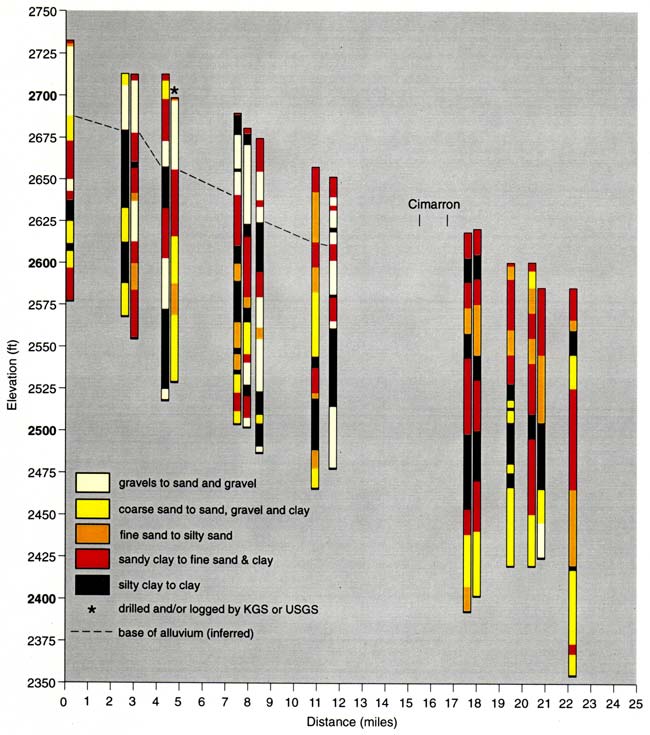
Figure A2. South of Arkansas River in Gray County
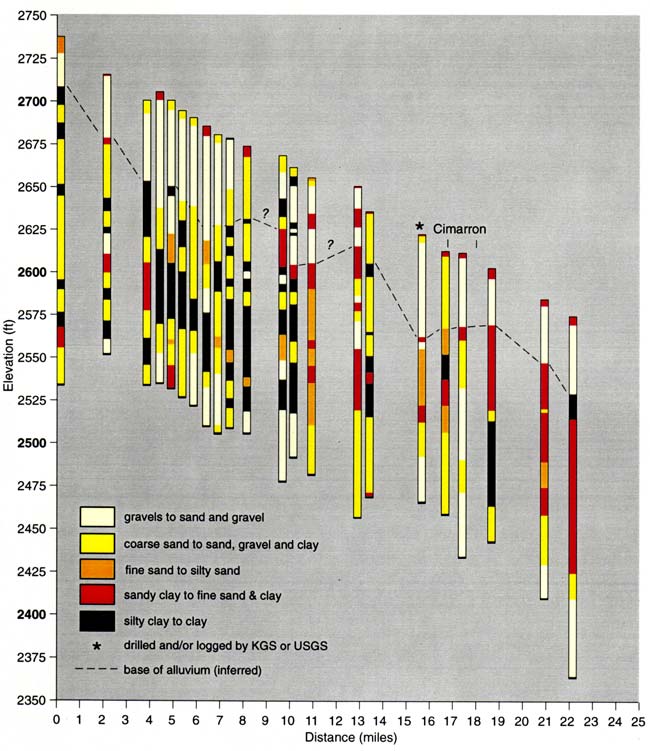
Figure A3. North of Arkansas River in Ford County
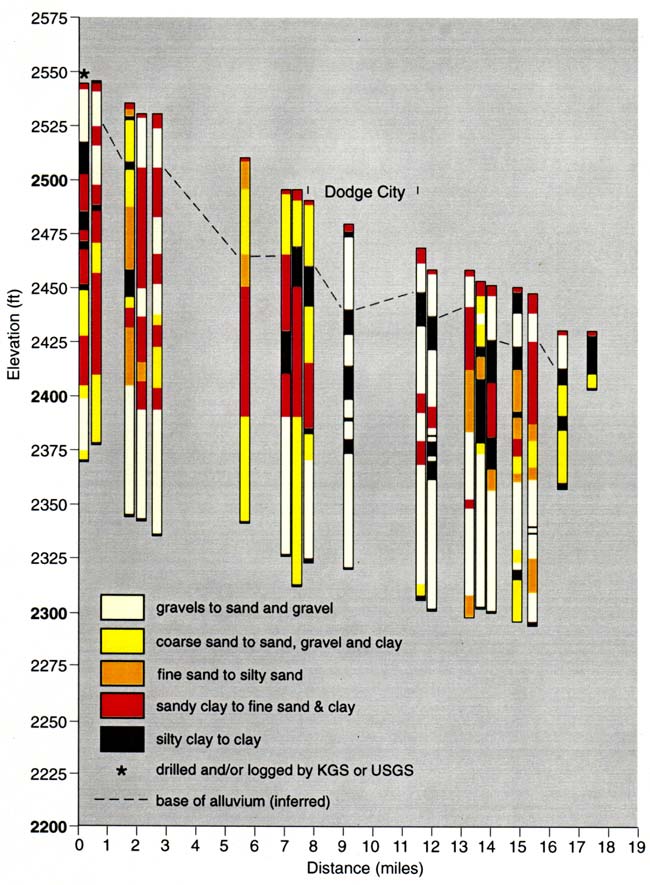
Figure A4. South of Arkansas River in Ford County
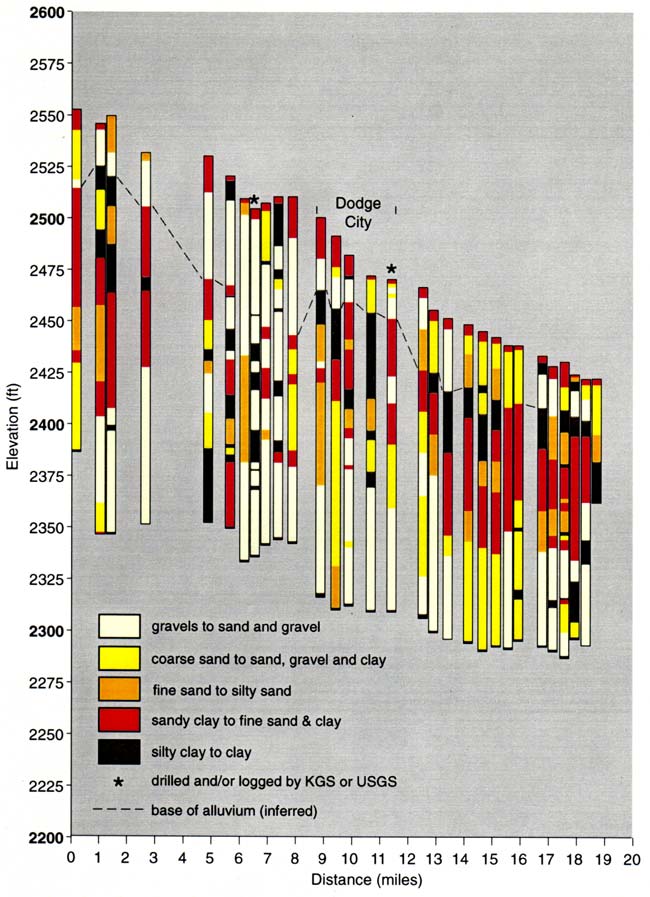
Figure A5. Western Gray County
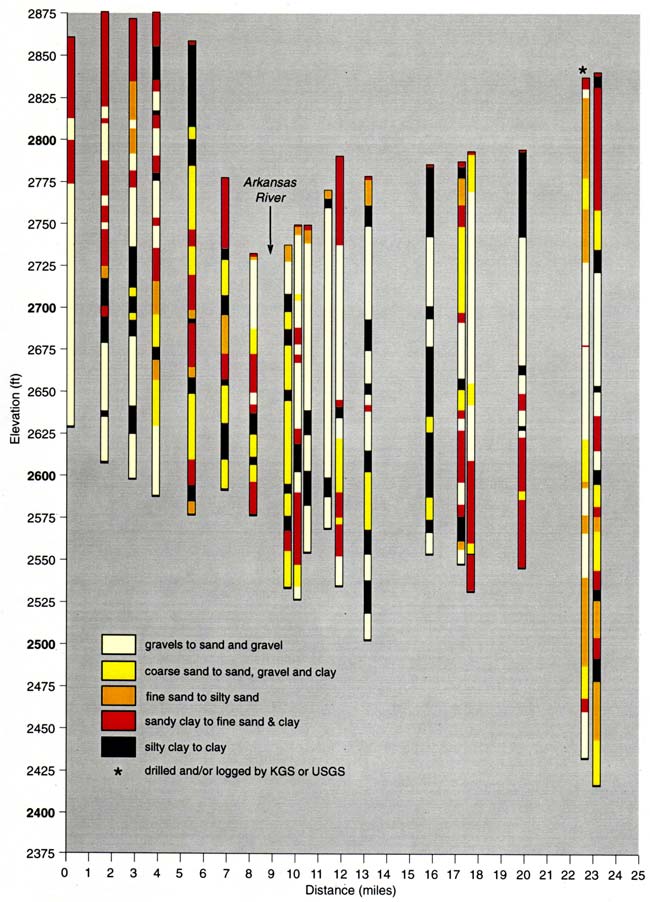
Figure A6. Cimarron
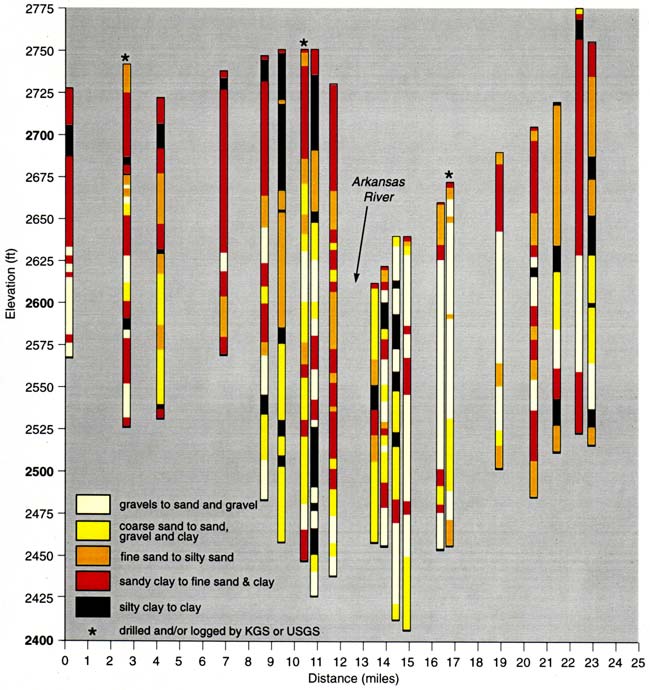
Figure A7. Western Ford County
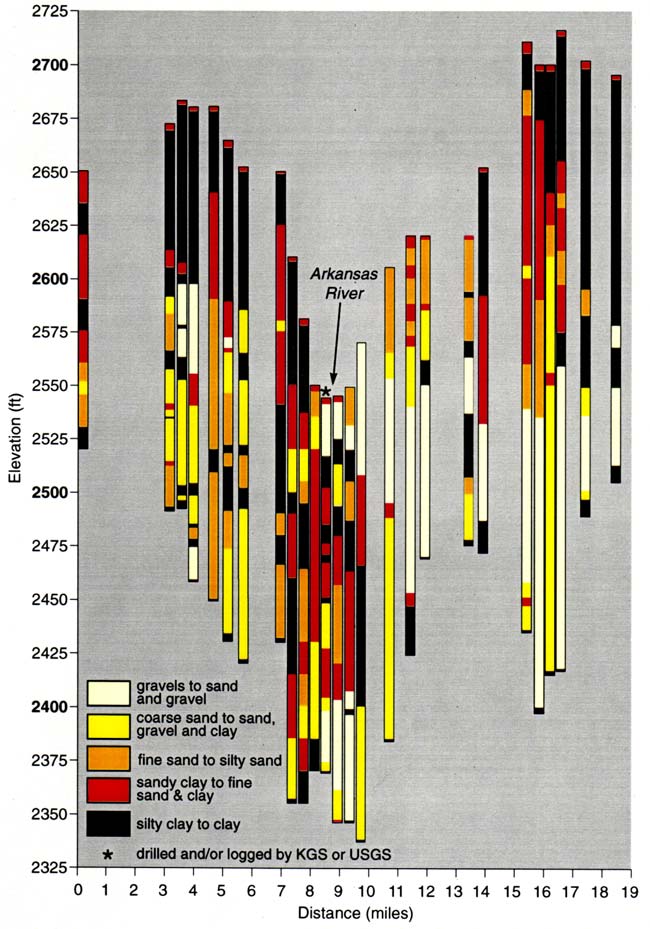
Figure A8. Dodge City
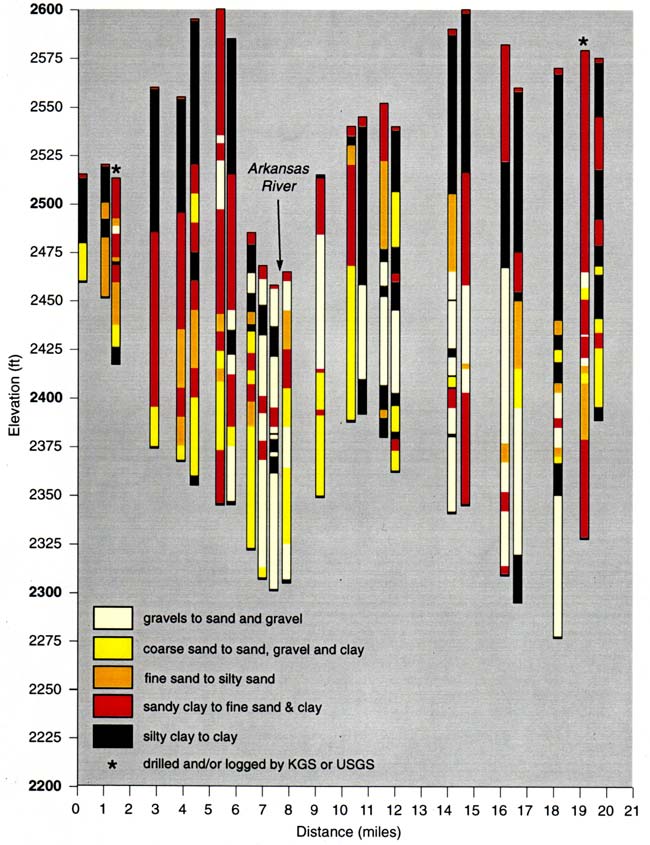
Kansas Geological Survey, Geohydrology
Placed online Nov. 26, 2007; original report dated June 1999
Comments to webadmin@kgs.ku.edu
The URL for this page is http://www.kgs.ku.edu/Hydro/Publications/1999/OFR99_23/index.html